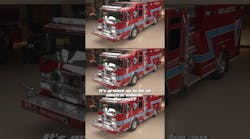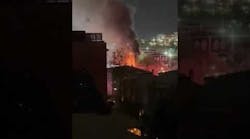Fire swept through a 200-by-300-foot sprinklered metal warehouse, destroying millions of dollars' worth of boxed furniture and challenging Houston, TX, firefighters to protect the company's adjoining 100,000-square-foot building housing its showroom, offices and a smaller warehouse.
Gallery Furniture reported the fire just after 8:30 P.M. on Thursday, May 21, 2009. The Houston Fire Department (HFD) sent a routine "heavy box," a first-alarm assignment of four engines, two ladder companies, two district chiefs, a safety officer and several EMS units to the scene at 6006 North Freeway (Interstate 45 North) between Tidwell and Parker roads, about seven miles north of downtown.
Initial Operations
Engine 58 was the first to arrive from quarters, about two-thirds of a mile away, reporting heavy fire at the northeast corner of the warehouse. A light northeasterly breeze kept smoke away from the apparatus, yet pushed it deeper into the warehouse. The incident commander, District 31 Chief Thomas Ponce, established his command post on Rosamond Street (the A side) at the north end of the warehouse within eyesight of Engine 58. He quickly summoned a second alarm as he saw fire spreading rapidly through the large building.
The furniture showroom next door was still open for business when the fire started. Showroom employees had to corral dozens of customers inside and get them out to the parking lot safely. Despite the enormity of that lot in front of the business, numerous parked cars made fire apparatus access difficult at first. Spectators from the freeway and even news media trucks continued to enter the store's parking lot at the very same time fire trucks were trying to get into position to protect the showroom. Soon, police had that chaotic situation under control. They cleared the lot of onlookers, and an HFD ladder truck was positioned near the showroom on its west (D) side.
District 34 Chief Joe Clark, the second chief officer on the first alarm, was assigned to monitor the south end of the warehouse where he observed thick smoke billowing from a dozen overhead doors. He radioed Ponce his suggestion to mount a strictly defensive attack. Ladder pipes were set up on three sides of the burning warehouse (off Rosamond, Werner and New Haven streets), but the most critical exposure, the huge showroom, separated from the blazing warehouse by only a covered walkway, had to be protected with handlines and ground monitors.
Controlling Fire Spread
Arriving on the second alarm, Ladder 74 was positioned on New Haven Street at the south end of the warehouse. Beneath the smoke pouring from the loading dock, flames could be seen progressing toward the south end. Before Ladder 74 could place its ladder pipe into operation, that entire end of the warehouse went up in flames so intense that they nearly burned the truck parked more than 150 feet away from the building.
"We had to hose down the truck first before we finished setting up the ladder pipe because it was getting so hot," said Ladder 74's officer, Senior Captain Glenn Pangarakis.
Once supplied with water, Ladder 74's aerial moved in to battle the flames. The truck was well-positioned. To the left of the loading dock doors was the showroom building, but in between was a pedestrian door that led to a long walkway between the two buildings. The aerial had a perfect shot to get water into the walkway area between the two structures.
The fight to save the showroom also used ground streams in that walkway. The first engine on the third alarm, Engine 11, stretched a 2½-inch line inside that walkway and put a ground monitor on the end to protect the southern half of the showroom building, which also included a smaller warehouse full of mattresses. Once Ladder 74 had the bulk of the heavy flames knocked down, that company trained its aerial there, too.
District Chief Josef Gregory, in charge of water supply, monitored engines being supplied by six nearby hydrants, each pumping through two four-inch hoselines, supplying at least three aerial master streams and multiple 2½-inch handlines. He confirmed with fire dispatchers that the city's water department had been notified to boost pressure in the mains in the area, a routine for multiple-alarm fires.
District 6 Chief Arthur Broussard was given command of the showroom (D-side) division. He sent Engines 4 and 6 inside to assess the situation and take action. Engine 4 took a 2½-inch line inside and put a ground monitor on it in the north end of the walkway next to the burning warehouse. Engine 6 took another 2½-inch line to the north end of the showroom and manned it.
"The doors from the showroom to the walkway were basic pedestrian doors and the exterior wall of the showroom was metal," said Engine 6 Captain Kirk Tolliver. "We set up with a 2½ in one of those doors and made sure the fire didn't get in the showroom."
Partially downwind from the fire, the showroom filled with smoke. The crew of Ladder 38 was sent to its roof to open windows on cupolas atop the structure. Smoke cleared quickly from most of the building. Eventually, HFD's "Big Blow," an airboat fan mounted on a trailer, was set up to clear the showroom completely of smoke.
The Investigation
A resident of an apartment complex across Rosamond Street on the north side of the warehouse told investigators at the fire that she heard an explosion before seeing flames on the northeast corner of the warehouse. By the next day, a multi-agency team of investigators began combing through the debris. The investigators looked closely at an auxiliary power generator that sat against the northeast wall of the warehouse. They were particularly interested in determining not just the origin of the fire, but why a sprinklered warehouse could have experienced such a fast-moving and devastating fire.
On May 28, Rob Elder, the case's lead investigator from the U.S. Bureau of Alcohol, Tobacco, Firearms and Explosives (ATF), told news media that arson was the likely cause of the fire. Flanked by the HFD's lead investigator on the case, Allison Stein, Elder estimated the total damage caused by the fire at $15 million to $20 million. Neither Stein nor Elder, though, would say any more about how the fire spread so quickly through a fully sprinklered warehouse or who might be suspected to have started the blaze.
A Strategic Review
This fire presented a number of challenging strategic issues, especially in its early stages, as is often the case. The HFD responded effectively with early recognition that the primary structure was headed for full involvement and, thus, quickly shifted its approach from an attempted interior knockdown inside a large warehouse to protecting the even larger exposure beside it.
- When the water supply being developed for a massive fire such as this taxes the hydrant system's ability to supply the required fire flow, crucial decisions must be made quickly to chose which devices and hoselines must be supplied versus which ones could be supplied. Obviously, such decisions must focus on the lives and property still most threatened by potential fire spread. Likewise, in a rapidly changing major fire like this, assign additional resources strictly to duties that will maximize their potential to save threatened lives and property, not just squirt water on what has already burned.
- If in command of a rapidly spreading fire such as this, give divisional and group commanders clear and concise instruction as to the goals you wish to achieve. On the other hand, keenly listen to reports they give in return to help paint a picture in your mind of how the event is progressing and what the greatest needs are at any given moment.
- Taking an overall defensive posture at a fire like this should not prohibit offensive measures from being taken from protected positions in adjoining exposures, such as quickly placing unmanned monitors where fire exposure is the greatest as well as placing charged 2½-inch handlines inside such exposures ready to combat any fire spread immediately and effectively.
- Maximize the use of aerial devices at fires of this magnitude by positioning them at points where their streams will have the most exposure-protection benefit as well as knockdown ability. Use them at low angles and maximum extension to avoid having to place the vehicle itself too close to intense flames or within the collapse zone.
- Request a small army of police early when it appears traffic and onlookers may hamper firefighting operations. Also, have a police supervisor sent to the command post so that, through unified command, you can quickly address traffic and crowd control issues and not have to do it through a series of dispatchers.
TOM McDONALD is a retired Houston, TX, Fire Department senior captain and current captain with the Southside Place, TX, Volunteer Fire Department.





